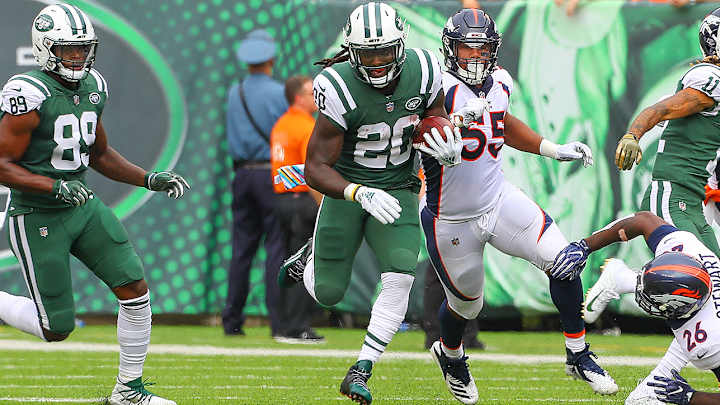Breaking Down Isaiah Crowell’s 219 Rushing Yards

The Jets temporarily worked themselves out of an identity crisis on Sunday amid a 34–16 win over the Broncos.
Sam Darnold finished 10-of-22 for 198 yards, three touchdowns and one interception. Most notably, though, New York rushed for 323 yards. Isaiah Crowell put up 219 yards on 15 carries which, according to Elias Sports, was the best per-carry average for one game in NFL history for a player with at least 15 touches. Crowell also topped the Jets’ franchise record for yards in a game.
This NFL season, we will likely see most of the league’s single-season passing records broken, so during their three-game losing streak, the Jets attempted to operate like many of the other high-wire passing offenses in the league knowing that Darnold could make the throws.
So how—and why—did the team gash one of the league’s most talented defenses on the ground, and why does it matter going forward? Let us count the ways…
I. Favorable matchups
Brian Winters didn’t mince words. When asked if the Broncos attempted to change fronts at all after Crowell’s first big run of the game, a 77-yard cutback touchdown with 13:59 to go in the second quarter, the Jets guard said: “No.”
“Hey, I mean, they’re a stout defense,” he added. “I’m sure they were sticking to their game plan.”
The plan, on almost half of Crowell’s carries, seemed to be a highly advantageous (for the Jets) six-man box. The Jets managed to prey on Denver’s aggressive, pass-rushing ends and ran Crowell almost exclusively on passing downs—that meant most of the time, there was an even six-on-six matchup between Denver’s two linemen, ends and linebackers and the Jets’ five offensive linemen and blocking tight end.
Of Crowell’s 15 carries, nine were on first-and-10 and two were on second-and-10.
The Jets lived on the space created between the rushing ends and the rest of the defense. Tight ends Eric Tomlinson and Chris Herndon and tackles Kelvin Beachum and Brandon Shell were instrumental in either steering Von Miller, Bradley Chubb and Shaquil Barrett upfield to create massive voids, or sandwiching them into the line to allow Crowell to bounce outside.
Odell Beckham Jr. Finds Plenty of Positives in Loss to Panthers
II. Slight adjustments
Crowell and Bilal Powell, who nearly cracked 100 yards, were mostly alternating series, and two drives before Crowell scored his 77-yard rushing touchdown, the Jets ran that same play.
“[Running backs coach] Stump Mitchell told me ‘on that play you could have looked outside—the front side or whatever. Do what you do, but just pay attention to it.’ So we ran the play again and I looked to the outside. Made the corner miss, made the safety miss.”
Most of Crowell’s runs seemed to be born out of similar concepts. The receivers stayed in tight on a majority of the rushes, which allowed Jermaine Kearse and Robby Anderson in particular to contribute to a few crucial chip blocks.
III. Missed tackles
“On the first long run, we have two guys unblocked,” Broncos head coach Vance Joseph said after the game. “We knew that play was going to bounce to the corner and the nickel player, and they didn’t tackle the guy. The free safety didn’t tackle him either. So he goes for a long touchdown.”
By an unofficial count, on Crowell’s 15 carries, the Broncos missed eight tackles. He also created four missed tackles via juke move or step back. It was a mix of both inspired performance and gassed defense. Denver was coming off short rest and a gutting loss to the division-rival Chiefs. It was their second east coast road trip in three weeks.
IV. The future
Darnold’s beautiful spot throws to deep specialist Robby Anderson were a large part of Sunday’s story but would not have been possible without the running game. After Crowell’s longest run, the Broncos shifted slightly, moving to a seven-man box instead of a six-man box which forced them to keep a single-high safety.
“The way we were running the ball, you have to play single high to have an extra guy in the box,” Darnold said.
Before this game, the Jets knew that without a rushing game they would not be able to properly accentuate their best players. The belief was that, after Detroit, they backed away from the running game too early after a few unsuccessful attempts. Head coach Todd Bowles admitted as much after the game.
“We knew we had to run the ball more and run the ball better,” he said. “I think that helped out a lot.”
How much it helped remains to be seen. The Jets have a chance to get back to .500 against a decimated Colts defense before facing a far more formidable defense in Minnesota on Oct. 21. The last time they faced an opponent that good—Jacksonville—they were exposed by putting Darnold in constant duress by forcing him into too many obvious passing downs with no chance of a successful run.
While they know another record-setting performance is unlikely, a more functional application of Sunday’s play-calling balance could serve Darnold well down the road.
